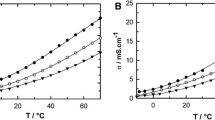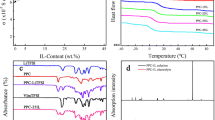Abstract
A piperidinium-based ionic liquid, N-methylpiperidinium-N-acetate bis(trifluoromethylsulfonyl)imide ([MMEPip][TFSI]), was synthesized and used as an additive to the electrolyte of LiFePO4 battery. The electrochemical performance of the electrolytes based on different contents of [MMEPip][TFSI] has been investigated. It was found that the [MMEPip][TFSI] significantly improved the high-rate performance and cyclability of the LiFePO4 cells. In the optimized electrolyte with 3 wt% [MMEPip][TFSI], 70 % capacity can be retained with an increase in rate to 3.5 C, which was 8 % higher than that of electrolyte without [MMEPip][TFSI]. For the Li/LiFePO4 half-cells, after 100 cycles at 0.1 C, the discharge capacity retention was 78 % in the electrolyte without ionic liquid. However, in the electrolyte with 3 wt% [MMEPip][TFSI], it displayed a high capacity retention of 91 %. The good electrochemical performances indicated that the [MMEPip][TFSI] additive would positively enhance the electrochemical performance of LiFePO4 battery.









Similar content being viewed by others
References
Wongittharoma N, Wang CH, Wang YC, Fey GTK, Li HY, Wu TY, Lee TC, Chang JK (2014) Charge-storage performance of Li/LiFePO4 cells with additive incorporated ionic liquid electrolytes at various temperatures. J Power Sources 260:268–275
Yang J, Zhou XY, Zou YL, Tang JJ (2011) A hierarchical porous carbon material for high power, lithium ion batteries. Electrochim Acta 56:8576–8581
Jansen AN, Dees DW, Abraham DP, Amine K, Henriksen GL (2007) Low-temperature study of lithium-ion cells using a LiSn micro-reference electrode. J Power Sources 174:373–379
Contestabile M, Morselli M, Paraventi R, Neat RJ (2003) A comparative study on the effect of electrolyte/additives on the performance of ICP383562 Li-ion polymer (soft-pack) cells. J Power Sources 119–121:943–947
Sasaki T, Abe T, Iriyama Y, Inaba M, Ogumi Z (2005) Suppression of an alkyl dicarbonate formation in Li-ion cells batteries, fuel cells, and energy conversion. J Electrochem Soc 152:A2046–A2050
McMillan R, Slegr H, Shu ZX, Wang WD (1999) Fluoroethylene carbonate electrolyte and its use in lithium ion batteries with graphite anodes. J Power Sources 81–82:20–26
Wrodnigg G, Wrodnigg T, Besenhard J, Winter M (1999) Propylene sulfite as film-forming electrolyte additive in lithium ion batteries. Electrochem Commun 1:148–150
Korepp C, Santner HJ, Fujii T, Ue M, Besenhard JO, Möller KC, Winter M (2006) 2-Cyanofuran—a novel vinylene electrolyte additive for PC-based electrolytes in lithium-ion batteries. J Power Sources 158:578–582
Sakaebe H, Matsumoto H (2003) N-methyl-N-propylpiperidinium bis(trifluoromethanesulfonyl)imide (PP13-TFSI)—novel electrolyte base for Li battery. Electrochem Commun 5:594–598
Huddleston JG, Visser AE, Reichert WM, Willauer HD, Broker GA, Rogers RD (2001) Characterization and comparison of hydrophilic and hydrophobic room temperature ionic liquids incorporating the imidazolium cation. Green Chem 3:156–164
Ohno H (2005) Electrochemical aspects of ionic liquids. Wiley, New Jersey
Fernicola A, Scrosati B, Ohno H (2006) Potentialities of ionic liquids as new electrolyte media in advanced electrochemical devices. Ionics 12:95–102
Armand M, Endres F, MacFarlane DR, Ohno H, Scrosati B (2009) Ionic-liquid materials for the electrochemical challenges of the future. Nat Mater 8:621–629
Galinski M, Lewandowski A, Stepniak I (2006) Ionic liquids as electrolytes. Electrochim Acta 51:5567–5580
Sun XG, Dai S (2010) A novel amperometric sensor for peracetic acid based on a polybenzimidazole-modified gold electrode. Electrochim Acta 55:4618–4626
Ishikawa M, Sugimoto T, Kikuta M, Ishiko E, Kono M (2006) Pure ionic liquid electrolytes compatible with a graphitized carbon negative electrode in rechargeable lithium-ion batteries. J Power Sources 162:658–662
Wongittharom N, Lee TC, Hsu CH, Fey GT, Huang KP, Chang JK (2013) Electrochemical performance of rechargeable Li/LiFePO4 cells with ionic liquid electrolyte: effects of Li salt at 25 °C and 50 °C. J Power Sources 240:676–682
Xiang HF, Yin B, Wang H, Lin HW, Ge XW, Xie S, Chen CH (2010) Improving electrochemical properties of room temperature ionic liquid (RTIL) based electrolyte for Li-ion batteries. Electrochim Acta 55:5204–5209
Sakaebe H, Matsumoto H, Tatsumi K (2005) Discharge-charge properties of Li/LiCoO2 cell using room temperature ionic liquids (RTILs) based on quaternary ammonium cation-effect of the structure. J Power Sources 146:693–697
Katayama Y, Yukumoto M, Miura T (2003) Electrochemical intercalation of lithium into graphite in room-temperature molten salt containing ethylene carbonate. Electrochem Solid-State Lett 6:A96–A97
Zhang ZX, Zhou HY, Yang L, Tachibana K, Kamijima K, Xu J (2008) Asymmetrical dicationic ionic liquids based on both imidazolium and aliphatic ammonium as potential electrolyte additives applied to lithium secondary batteries. Electrochim Acta 53:4833–4838
Wang ZN, Cai YJ, Dong T, Chen SM, Lu XM (2013) Triethylbutylammonium bis(trifluoromethanesulphonyl)imide ionic liquid as an effective electrolyte additive for Li-ion batteries. Ionics 19:887–894
Mai YJ, Luo H, Zhao XY, Wang JL, Davis J, Lyons LJ, Zhang LZ (2014) Organosilicon functionalized quaternary ammonium ionic liquids as electrolytes for lithium-ion batteries. Ionics 20:1207–1215
Lee JS, Quan ND, Hwang JM, Bae JY, Kim H, Cho BW, Kim HS, Lee H (2006) Ionic liquids containing an ester group as potential electrolytes. Electrochem Commun 8:460–464
Gholamreza VN, Mostafa V, Morteza A, Ibrahim A (2012) Effect of temperature on the physical properties of 1-butyl-3-methylimidazolium based ionic liquids with thiocyanate and tetrafluoroborate anions, and 1-hexyl-3-methylimidazolium with tetrafluoroborate and hexafluorophosphate anions. J Chem Thermodyn 54:148–154
Okoturo OO, Vandernoot TJ (2004) Temperature dependence of viscosity for room temperature ionic liquids. J Electroanal Chem 568:167–181
Bonhote P, Dias A, Papageorigiou N, Kalyanasundaram K, Grätzel M (1996) Hydrophobic, highly conductive ambient-temperature molten salts. Inorg Chem 35:1168–1178
Kanazawa A, Tsutsumi O, Ikeda T, Nagase Y (1997) Novel thermotropic liquid crystals without a rigid core formed by amphiphiles having phosphonium ions. J Am Chem Soc 119:7670–7675
Fang SH, Jin Y, Yang L, Hirano SI, Tachibana K, Katayama S (2011) Functionalized ionic liquids based on quaternary ammonium cations with three or four ether groups as new electrolytes for lithium battery. Electrochim Acta 56:4663–4671
Ren R, Zuo Y, Zhou Q, Zhang HL, Zhang SJ (2011) Density, excess molar volume and conductivity of binary mixtures of the ionic liquid 1,2-dimethyl-3-hexylimidazolium bis(trifluoromethylsulfonyl)imide and dimethyl carbonate. J Chem Eng Data 56:27–30
Kunze M, Jeong S, Paillard E, Schönhoff M, Winter M, Passerini S (2011) New insights to self-aggregation in ionic liquid electrolytes for high-energy electrochemical devices. Adv Energy Mater 1:274–281
Evans J, Vincent CA, Bruce PG (1987) Electrochemical measurement of transference numbers in polymer electrolytes. Polymer 28(13):2324–2328
Zugmann S, Fleischmann M, Amereller M, Gschwind RM, Wiemhöfer HD, Gores HJ (2011) Measurement of transference numbers for lithium ion electrolytes via four different methods, a comparative study. Electrochim Acta 56:3926–3933
Yoon H, Howlett PC, Best AS, Forsyth M, MacFarlane DR (2013) Fast charge/discharge of Li Metal batteries using an ionic liquid electrolyte. J Electrochem Soc 160(10):A1629–A1637
Evans J, Vincent CA, Bruce PG (1987) Electrochemical measurement of transference numbers in polymer electrolytes. Polymer 28:2324–2328
Zhao JS, Wang L, He XM, Wan CR, Jiang CY (2008) Determination of lithium-ion transference numbers in LiPF6-PC solutions based on electrochemical polarization and NMR measurements. J Electrochem Soc 155(10):A292–A296
Acknowledgments
The authors would like to thank the 973 program (No. 2015CB251401), the National Natural Science Foundation of China (No. 51304183), the Special Funds of the National Natural Science Foundation of China (No. 21127011), the International Cooperation and Exchange of the National Natural Science Foundation of China (No. 21210006), and the Program of National High Technology Research and Development Program of China (863 Program) (No. 2012AA063001).
Author information
Authors and Affiliations
Corresponding author
Electronic supplementary material
Below is the link to the electronic supplementary material.
ESM 1
(DOC 3040 kb)
Rights and permissions
About this article
Cite this article
Dong, T., Zhang, L., Chen, S. et al. A piperidinium-based ionic liquid electrolyte to enhance the electrochemical properties of LiFePO4 battery. Ionics 21, 2109–2117 (2015). https://doi.org/10.1007/s11581-015-1388-0
Received:
Revised:
Accepted:
Published:
Issue Date:
DOI: https://doi.org/10.1007/s11581-015-1388-0




